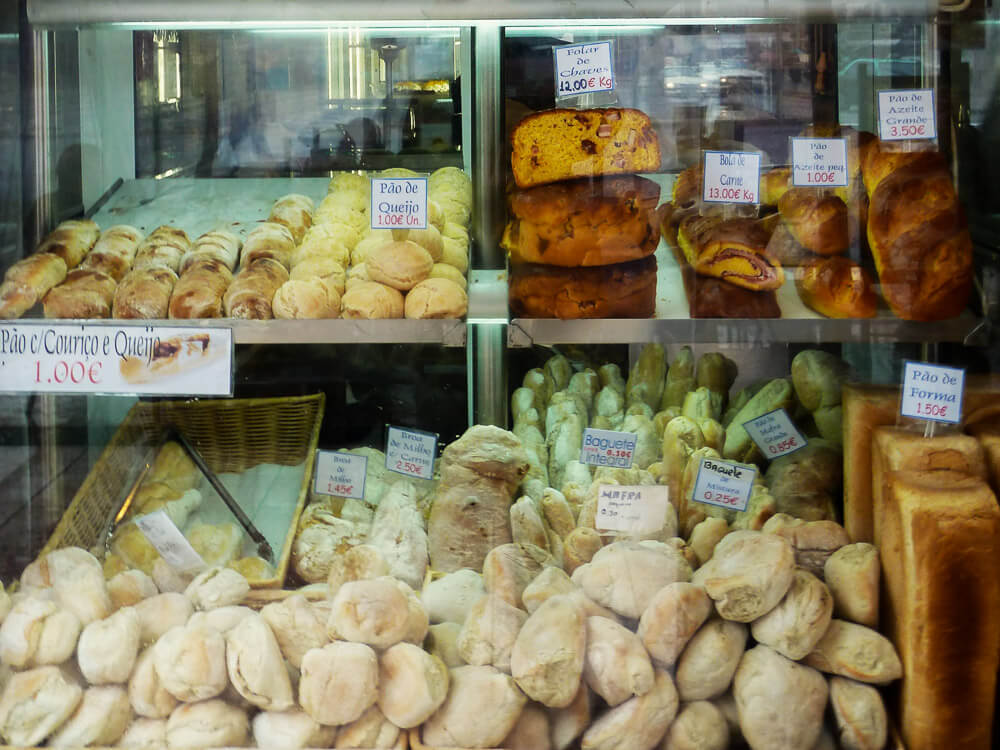Bread, or pão in Portuguese, is an integral part of the Portuguese diet and culture. More than just a food item, it’s a staple present at every meal, from morning toasts to dinners. Its significance in daily life is reflected in the abundance of bakeries across Portugal, ensuring that fresh bread is always available.
Each region offers its own variety, influenced by local ingredients, taste preferences, and traditional pairings. To help you get initiated on the wonderful world of Portuguese breads, I’ve made a list with all the most popular types.
I hope you’re not cutting back on carbs, because you’ll definitely be craving some bread after reading about all of these delicious kinds of Portuguese breads!

Index
1. The most popular Portuguese bread
1.1. Papo-Seco (Portuguese Bun)

Papo-seco, also known as carcaça, is a single-serving wheat flour bread found across Portugal. This type of bread has an elongated shape with a tear in the middle, giving it its unique look. The interior is soft and fluffy, while the crust is crunchy.
The names for this bread vary by region: it’s called Molete in the North of Portugal, Papo Seco in the central regions, and Carcaça in Lisbon. Despite these regional differences in name, the bread remains consistent in its basic characteristics and popularity.
Commonly eaten for breakfast or as a snack, papo-seco serves well as a base for sandwiches. Its neutral flavor makes it suitable to pair with both sweet and savory toppings, and you’ll often find it accompanying soups or served alongside main dishes at lunch or dinner.
One of the most affordable types of Portuguese bread, papo-seco is widely available in bakeries throughout Portugal. Its low cost and accessibility make it a staple item that locals rely on daily. Whether you’re visiting urban centers or rural areas, you’ll likely encounter this Portuguese bun wherever you go.
1.2. Broa de Milho (Portuguese Cornbread)

Broa de Milho, or Portuguese cornbread, comes from northern Portugal and the Azores, but is also found in Brazil and Galicia. This bread is made with a mix of corn and wheat flours, though it was originally made with rye flour before corn was introduced to Europe.
As one of the oldest bread types in Portugal, dating back to Visigothic times, Broa de Milho holds an important place in Portuguese culinary history.
The bread’s yellow interior comes from the cornmeal used in its preparation. It has a distinct flavor and moist texture that makes it suitable for various dishes like soups, cheese, butter, meats, and stews.
Once considered poor man’s food due to its simple ingredients and ease of preparation, Broa de Milho has become a staple enjoyed by many people, and today, you can find Broa de Milho in bakeries throughout Portugal.
1.3. Pão Alentejano (Alentejo Bread)

Pão Alentejano, or Alentejo Bread, originates from the Alentejo region of Portugal, which is often called Portugal’s barn due to its abundance of wheat flour, the main ingredient of this type of bread.
The bread has a light brown crust and a fluffy core, with a slightly sour taste that comes from the use of sourdough. For more authenticity, it should be baked in wood ovens. Besides that, pão Alentejano has a crown on top, which is another thing that sets it apart from other types of bread.
In the Alentejo region, this versatile bread plays an essential role in dishes like Açorda and Migas, and can also be enjoyed as a complement to meals or with butter or cheese.
1.4. Pão de Mafra (Mafra Bread)

Pão de Mafra, or Mafra Bread, is a popular bread produced in the town of Mafra, about 40 kilometers from Lisbon. This bread is known for its crunchy crust and light interior. Its high hydration results in irregular holes throughout the loaf, giving it a rustic flavor.
Mafra Bread comes in different formats, including round or elongated loaves and single serving sizes called “bolas de Mafra”. The specific characteristics of this bread come from its regional production methods, which uses local ingredients and is baked in traditional brick ovens.
Despite being made in Mafra, Pão de Mafra is accessible throughout Portugal, especially in Lisbon where it has become one of the most popular types of bread. Its availability makes it convenient for both locals and visitors to enjoy this piece of Portuguese culinary tradition.
1.5. Bolo do Caco (Madeiran Bread)

Bolo do Caco is a bread from Madeira, a Portuguese archipelago. Made mainly from flour and sweet potato, it reflects the island’s historical lack of cereals. Its flat, round shape sets it apart from other types of Portuguese bread.
Traditionally cooked on a basalt stone slab known as Caco, which gives it its unique texture and flavor, Bolo do Caco can also be prepared on a frying pan. It’s often served warm with garlic butter or used to make sandwiches filled with ham and cheese, steak, sausages, or presunto.
Bolo do Caco has become popular beyond Madeira and can now be found in other parts of Portugal, and its versatility makes it an excellent accompaniment to many traditional dishes across the country. The combination of sweet potato and flour provides a subtle sweetness that complements savory fillings well.
1.6. Pão de Centeio (Rye Bread)

Pão de Centeio, or rye bread, is a traditional brown bread made mostly with rye flour. Historically, this bread was important due to the scarcity of wheat, making rye a key grain for sustenance.
This loaf is known for its dense texture and dark crust, and has been common in the interior center of Portugal for generations. Traditionally baked in wooden ovens that enhance the bread’s natural taste, Pão de Centeio is a great pairing to various local dishes, such as meats and cheeses.
Despite changes over time, Pão de Centeio remains integral to Portuguese cuisine, standing out among other Portuguese breads for its unique characteristics and historical significance.
1.7. Broa de Avintes (Avintes Cornbread)

Broa de Avintes, or Avintes cornbread, is a traditional dark bread from the village of Avintes near Porto. It’s made using a mix of white and yellow corn flour, malt flour, rye flour, hot water, yeast, and salt, which gives it its dense texture and distinct flavor.
The flavor of Broa de Avintes is bittersweet with an underlying intensity and crumb that remains moist even after baking. Its loaves can range in size from 1kg to 9kg.
Considered a comfort food in northern Portugal, Broa de Avintes pairs well with various dishes of northern Portugal. It’s often served alongside soups or grilled fish and goes well with sweet jams and smoked sausages like chouriço.
1.8. Bolo Lêvedo (Portuguese Muffins)

Bolo lêvedo, a sweet wheat bread from the Azores, particularly Furnas in São Miguel, has gained popularity beyond its island origins. Originally savory, this bread is now sweet with a toasted exterior and slightly undercooked center.
Traditionally cooked in wood ovens, bolo lêvedo is now often made on frying pans, making it easier for home cooks to prepare. In fact, its preparation method makes it similar to English muffins or crumpets.
These muffins are great for breakfast when toasted and paired with jam, fresh cheese, or butter, and also make good panini-style sandwiches with ham and cheese. You can find bolo lêvedo in Azorean stores like Mercearia dos Açores in Lisbon.
1.9. Pão de Alfarroba (Carob Bread)

Recognized as a superfood and found in health food stores, carob, or alfarroba in Portuguese, was first introduced to Portugal by the Moors. Now, pão de Alfarroba, or carob bread, is becoming increasingly popular due to its health benefits and unique flavor.
The bread is made with carob flour, and has a dark color with a nutty and slightly sweet taste. It’s usually mixed with wheat flour for leavening, and it’s available both as large loaves and individual buns.
Whether part of daily meals or special occasions, pão de alfarroba is an option for those looking for nutritious alternatives within Portuguese bread types.
1.10. Pão de Deus (Portuguese Coconut Buns)

Pão de Deus, which means Bread of God, is a traditional Portuguese dessert from the 15th century. Historically made in convents, this treat is usually eaten on All Saints’ Day as part of the pão-por-deus tradition. However, its popularity also made it become a common breakfast item.
The bread is a round brioche topped with grated coconut and an egg-based cream. Baked until golden and crispy on top, Pão de Deus offers a mix of soft interior and crunchy exterior. You can eat Pão de Deus alone or as a sandwich, as it pairs well with savory fillings like ham, cheese, and cold cuts.
1.11. Regueifa (Round Wheat Bread)

Regueifa is a round wheat bread from northern Portugal, also called Rosca or Sunday bread. It’s less common in Lisbon and the south, making it a regional specialty to try if you’re in the north. Often enjoyed during Easter, Regueifa has a soft texture and crust.
This bread is best eaten fresh as it doesn’t keep well, losing its qualities quickly after baking. There’s also a sweet version known as Regueifa doce, which includes sugar, cinnamon, lemon zest, and sometimes Port wine.
1.12. Folar da Páscoa (Portuguese Easter Bread)

Folar da Páscoa is a traditional Portuguese brioche-style bread eaten during Easter, both in sweet and savory varieties. It holds a special place among Portuguese bread types, with its nest-like shape with a boiled egg baked into the dough.
The egg symbolizes resurrection and rebirth, aligning with the religious meaning of Easter. Beyond that, Folar da Páscoa represents friendship and reconciliation. Sharing this bread during Easter celebrations reflects these values, making it more than just food but also part of social customs.
Whether you choose the sweet or savory version, Folar da Páscoa provides an authentic taste of Portuguese culture. Its unique features make it stand out among other Portuguese breads and an important part of any Easter celebration in Portugal.
1.13. Pão com Chouriço (Portuguese Sausage Bread)

Pão com chouriço, also known as Portuguese sausage bread, is a version of the more widely known sausage roll, and can be found in bakeries and cafés throughout the country. This snack features sliced chouriço, a type of Portuguese smoked sausage, placed in bread dough and then baked.
This snack falls under various types of Portuguese bread, each bringing its own twist to this item. The dough used can range from simple white bread to more rustic varieties, catering to different tastes. Regardless of the type, the combination remains delicious.
Typically enjoyed around lanche time at approximately 4 pm, pão com chouriço serves as an afternoon pick-me-up. Its hearty nature makes it satisfying enough to stave off hunger until dinner, while still being light enough not to spoil one’s appetite entirely.
2. Essence of Portuguese Bread
Portuguese bread is renowned for its unique texture, crustiness, and flavor, achieved through a slow fermentation process and traditional baking methods. They’re usually made from simple ingredients like flour, water, salt, and yeast, and receive a distinctive smoky flavor due to being baked in wooden ovens.
The craft of bread-making in Portugal is deeply rooted in heritage and local customs, with techniques handed down through generations. It’s a very important tradition in the country, accompanying all kinds of meals.
Various regional breads, such as Pão Alentejano and Broa de Milho, showcase the diversity within Portuguese bread while maintaining a commitment to quality and tradition. This dedication to traditional methods really underscores the importance of Portuguese bread in cultural identity, ensuring the preservation of its culinary legacy.
What is your favorite type of bread?

From sourdough loaves to regional specialties, each type of Portuguese bread offers a taste of the country’s traditions and culinary heritage. Each variety has its own texture and taste profile, providing a different experience with each bite.
That’s why, during your trip, trying some popular types of Portuguese bread should definitely be on your list. No matter what you choose, there’s no wrong choice when it comes to Portuguese bread!







